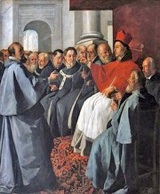


St Bonaventure welcomes representatives of the Orthodox Church at the Council of Lyons
Panel (1627) by Francisco de Zurbaran
Louvre, Paris
An entry in the Roman Martyrology under 15th July reads: “At Lyons in France, the death of St. Bonaventure, cardinal and bishop of Albano, confessor and doctor of the Church, of the Order of Friars Minor, who is famed for his learning and the sanctity of his life.”
St Bonaventure, who was born in Civita di Bagnoregio (Viterbo) in ca, 1217 and named Giovanni Fidanza. He joined the Franciscan Order in 1243 and was sent to study at their school in Paris, becoming became the Master of the school there in 1253. He was a fine theologian and a good administrator, renowned for his gentleness, his courtesy and his frugal lifestyle. He became Minister General of the Franciscans in 1257, when his patron, John of Parma was forced to resign in difficult circumstances.
St Bonaventure stabilised the dissent within the Order to such an extent that he is sometimes referred to as its second founder. He pushed through internal reforms, and worked hard to improve the external perception of the Order. He also accelerated the move to greater clericalism within it.
In 1260-3, St Bonaventure wrote the definitive biography of St Francis, the Vita Maior, and the chapter meeting of 1266 decreed that all earlier biographies should be suppressed. Most importantly, he provided a new interpretation of the Franciscan Rule, which allowed that a friar could receive and use what was essential to life, but could own nothing and should live a simple life, taking no more than the necessities.
St Bonaventure became a cardinal in 1273 and died in 1274, while attending the Council of Lyons. Pope Nicholas III supported his interpretation of the Rule in 1279, and prohibited further discussion of the matter.
Canonisation
St Bonaventure was buried in the Franciscan church at `lyons. No attempt seems to have been made to secure his canonisation at this stage, although Dante placed him among the saints in his "Paradiso". His cause was probably a casualty of the growing dissension between the two wings of the Franciscan Order.
When St Bonaventure's remains were translated to the new Franciscan church at Lyons in 1434, his head was found in a perfect state of preservation, the tongue being as red as in life. This apparent miracle moved the people of Lyons to choose him as their patron , and also revived the case for his canonization.
The Franciscan Pope Sixtus IV canonised St Bonaventure in 1482. He was declared a Doctor of the Church in 1588, just a year after the same honour had been given to his contemporary, the Dominican St Thomas Aquinas.
The relics were translated again in 1490 (i.e. after his canonisation). His right arm was detached at that time and enclosed in a reliquary that Brother Francesco Sansone took back to Italy. It is still venerated at the Duomo, Bagnoregio.



